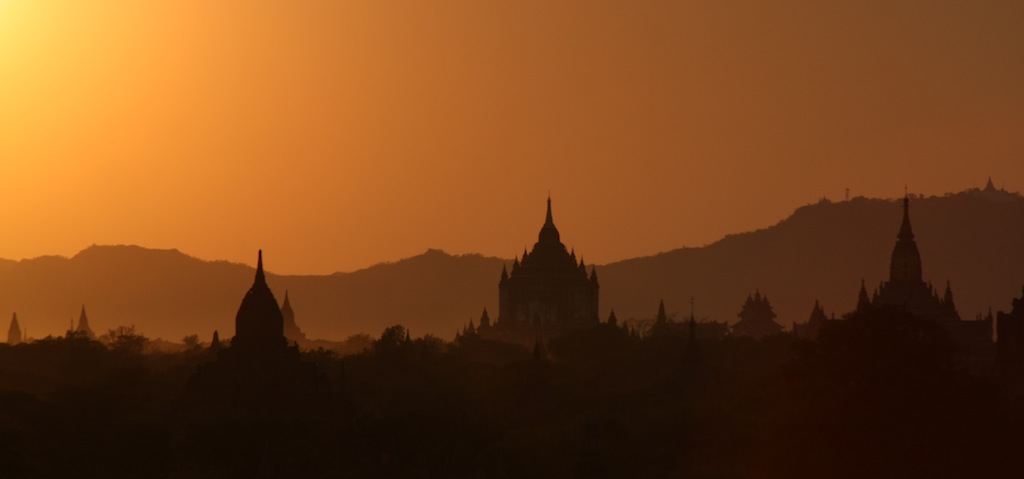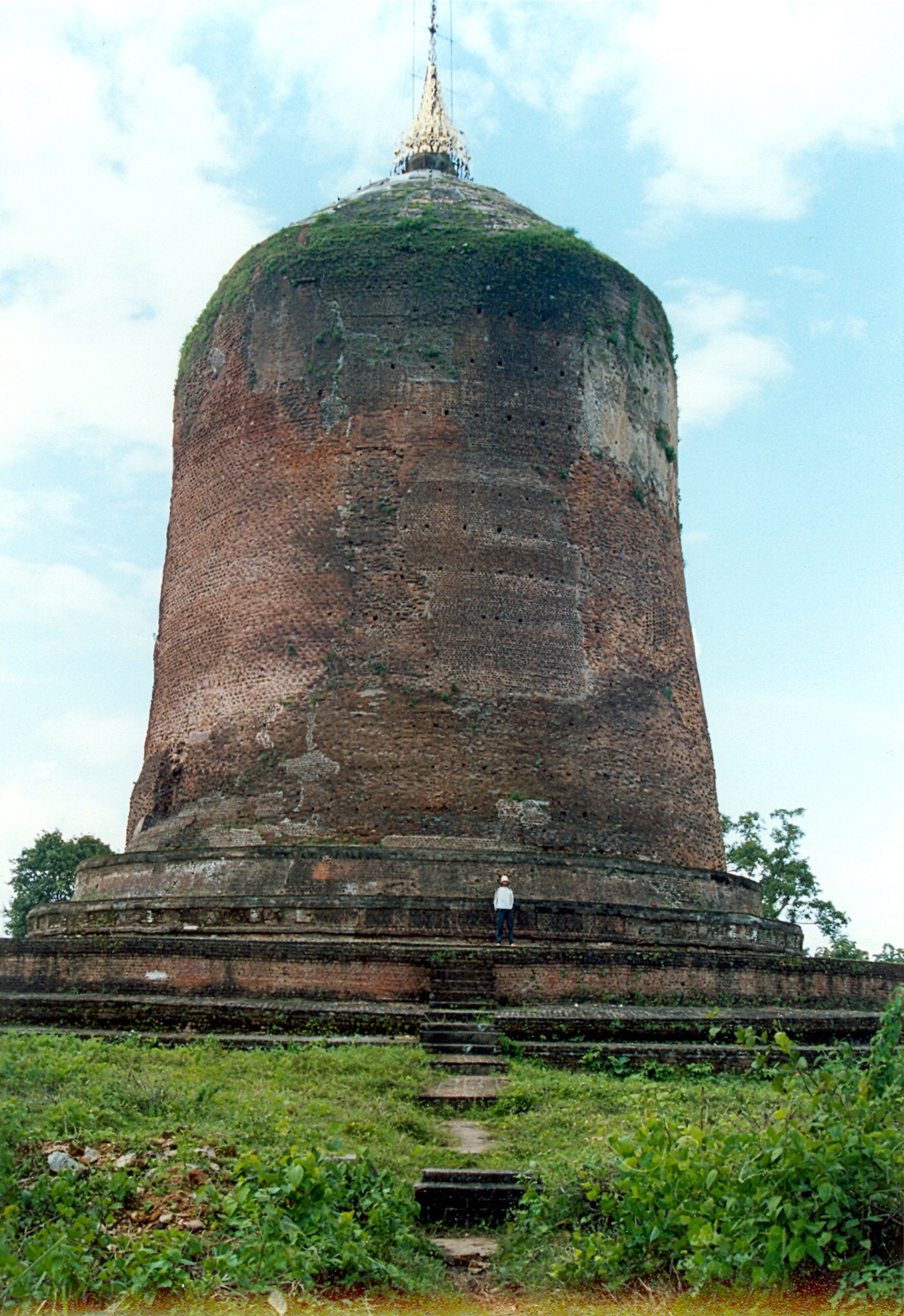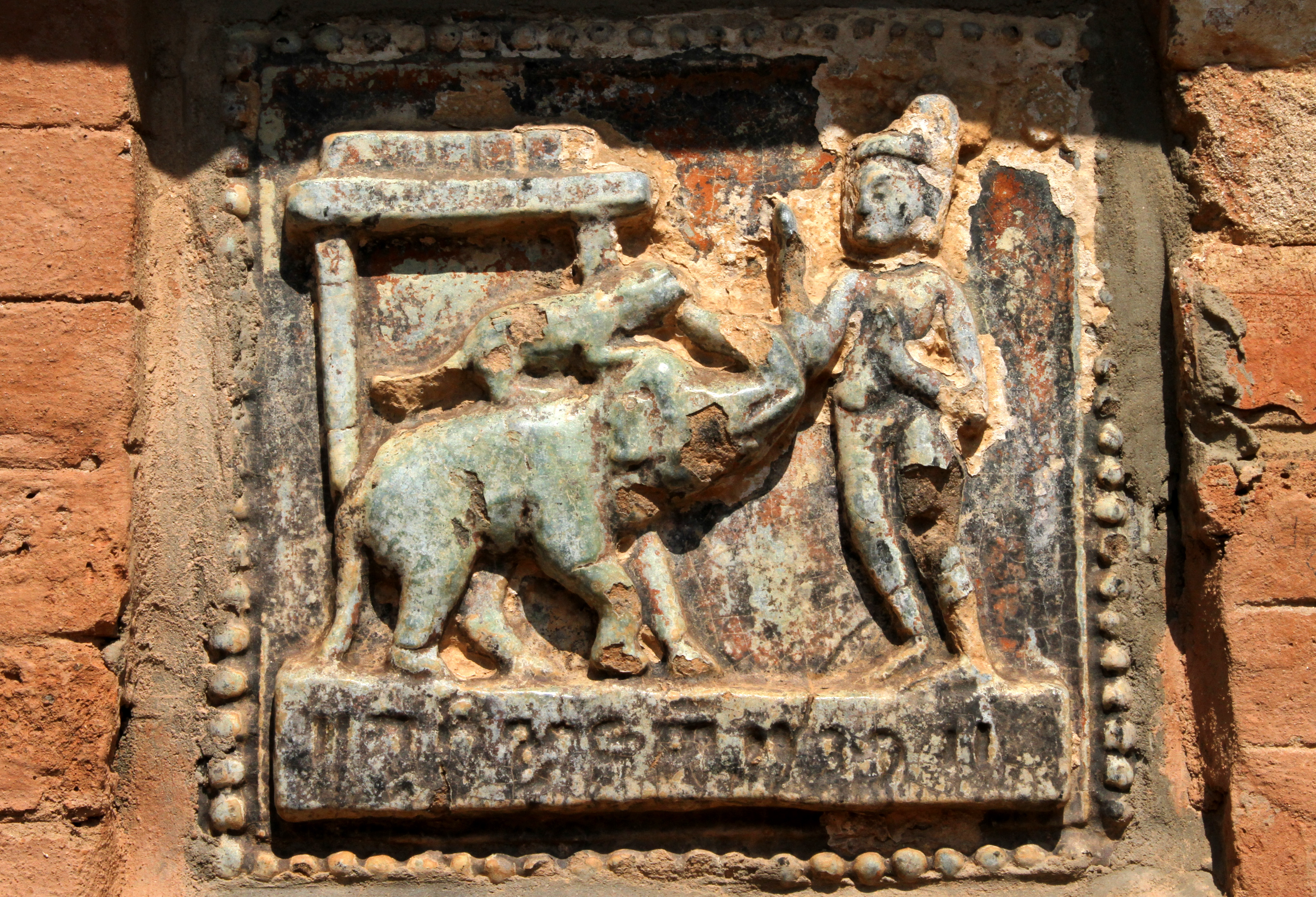|
Lawkananda Pagoda
Lawkananda Pagoda ( my, လောကနန္ဒာစေတီ; ; also spelt Lokananda, literally "joy of the world") is a Buddhist zedi located in Bagan, Burma (formerly Pagan). It was erected on the bank of the Ayeyarwaddy River, and built during the reign of King Anawrahta. It contains a replica of a Buddha tooth relic. The Lawkananda Pagoda festival along with local foodand handicrafts is celebrated in the month of July every year. Since it takes place in the rainy season, very few outside visitors are able to attend the festival.http://portal.gms-eoc.org/uploads/resources/903/attachment/Status%20Report%20on%20Myanmar%20Designated%20Ecotourism%20Sites.pdf On 24 May 2003, a bejewelled umbrella (''hti'') was hoisted to the top of the pagoda. See also *Cetiya *Burmese pagoda *Bupaya Pagoda *Dhammayazika Pagoda *Mingalazedi Pagoda *Shwesandaw Pagoda (Bagan) *Shwezigon Pagoda *Relic of the tooth of the Buddha The relic of the tooth of Buddha (Pali ''danta dhātuya'') is vener ... [...More Info...] [...Related Items...] OR: [Wikipedia] [Google] [Baidu] |
Bagan
Bagan (, ; formerly Pagan) is an ancient city and a UNESCO World Heritage Site in the Mandalay Region of Myanmar. From the 9th to 13th centuries, the city was the capital of the Bagan Kingdom, the first kingdom that unified the regions that would later constitute Myanmar. During the kingdom's height between the 11th and 13th centuries, more than 10,000 Buddhist temples, pagodas and monasteries were constructed in the Bagan plains alone, of which the remains of over 2200 temples and pagodas survive. The Bagan Archaeological Zone is a main attraction for the country's nascent tourism industry. Etymology Bagan is the present-day standard Burmese pronunciation of the Burmese word ''Pugan'' ( my-Mymr, ပုဂံ), derived from Old Burmese ''Pukam'' ( my-Mymr, ပုကမ်). Its classical Pali name is ''Arimaddanapura'' ( my-Mymr, အရိမဒ္ဒနာပူရ, lit. "the City that Tramples on Enemies"). Its other names in Pali are in reference to its extreme dry zone cl ... [...More Info...] [...Related Items...] OR: [Wikipedia] [Google] [Baidu] |
Mandalay Region
Mandalay Region ( my, မန္တလေးတိုင်းဒေသကြီး, ; formerly Mandalay Division) is an administrative divisions of Myanmar, administrative division of Myanmar. It is located in the center of the country, bordering Sagaing Region and Magway Region to the west, Shan State to the east, and Bago Region and Kayin State to the south. The regional capital is Mandalay. To the south of the region lies the national capital of Naypyidaw. The division consists of eleven districts, which are subdivided into 28 townships and 2,320 wards and village-tracts. Mandalay Region is important in Economy of Myanmar, Myanmar's economy, accounting for 15% of the national economy. It is under the administration of the Mandalay Region Government. History The history of Mandalay Region is the same as that of much of Upper Myanmar except that for much of Burmese history, the political power emanated out of royal capitals located in Mandalay Region. The country's present capit ... [...More Info...] [...Related Items...] OR: [Wikipedia] [Google] [Baidu] |
Theravada Buddhism
''Theravāda'' () ( si, ථේරවාදය, my, ထေရဝါဒ, th, เถรวาท, km, ថេរវាទ, lo, ເຖຣະວາດ, pi, , ) is the most commonly accepted name of Buddhism's oldest existing school. The school's adherents, termed Theravādins, have preserved their version of Gautama Buddha's teaching or ''Dharma (Buddhism), Buddha Dhamma'' in the Pāli Canon for over two millennia. The Pāli Canon is the most complete Buddhist canon surviving in a Indo-Aryan languages, classical Indian language, Pali, Pāli, which serves as the school's sacred language and ''lingua franca''.Crosby, Kate (2013), ''Theravada Buddhism: Continuity, Diversity, and Identity'', p. 2. In contrast to ''Mahāyāna'' and ''Vajrayāna'', Theravāda tends to be conservative in matters of doctrine (''pariyatti'') and monastic discipline (''vinaya''). One element of this conservatism is the fact that Theravāda rejects the authenticity of the Mahayana sutras (which appeared c. ... [...More Info...] [...Related Items...] OR: [Wikipedia] [Google] [Baidu] |
Myanmar
Myanmar, ; UK pronunciations: US pronunciations incl. . Note: Wikipedia's IPA conventions require indicating /r/ even in British English although only some British English speakers pronounce r at the end of syllables. As John C. Wells, John Wells explains, the English spellings of both Myanmar and Burma assume a non-rhotic variety of English, in which the letter r before a consonant or finally serves merely to indicate a long vowel: [ˈmjænmɑː, ˈbɜːmə]. So the pronunciation of the last syllable of Myanmar as [mɑːr] or of Burma as [bɜːrmə] by some speakers in the UK and most speakers in North America is in fact a spelling pronunciation based on a misunderstanding of non-rhotic spelling conventions. The final ''r'' in ''Myanmar'' was not intended for pronunciation and is there to ensure that the final a is pronounced with the broad a, broad ''ah'' () in "father". If the Burmese name my, မြန်မာ, label=none were spelled "Myanma" in English, this would b ... [...More Info...] [...Related Items...] OR: [Wikipedia] [Google] [Baidu] |
Anawrahta
Anawrahta Minsaw ( my, အနော်ရထာ မင်းစော, ; 11 May 1014 – 11 April 1077) was the founder of the Pagan Empire. Considered the father of the Burmese nation, Anawrahta turned a small principality in the dry zone of Upper Burma into the first Burmese Empire that formed the basis of modern-day Burma (Myanmar).Harvey 1925: 34Htin Aung 1967: 38 Historically verifiable Burmese history begins with his accession to the Pagan throne in 1044.Coedès 1968: 133, 148–149, 155 Anawrahta unified the entire Irrawaddy valley for the first time in history, and placed peripheral regions such as the Shan States and Arakan (Rakhine) under Pagan's suzerainty. He successfully stopped the advance of Khmer Empire into Tenasserim coastline and into Upper Menam valley, making Pagan one of two main kingdoms in mainland Southeast Asia. A strict disciplinarian, Anawrahta implemented a series of key social, religious and economic reforms that would have a lasting impact ... [...More Info...] [...Related Items...] OR: [Wikipedia] [Google] [Baidu] |
Stupa
A stupa ( sa, स्तूप, lit=heap, ) is a mound-like or hemispherical structure containing relics (such as ''śarīra'' – typically the remains of Buddhist monks or nuns) that is used as a place of meditation. In Buddhism, circumambulation or ''pradakhshina'' has been an important ritual and devotional practice since the earliest times, and stupas always have a ''pradakhshina'' path around them. The original South Asian form is a large solid dome above a tholobate or drum with vertical sides, which usually sits on a square base. There is no access to the inside of the structure. In large stupas there may be walkways for circumambulation on top of the base as well as on the ground below it. Large stupas have or had ''vedikā'' railings outside the path around the base, often highly decorated with sculpture, especially at the torana gateways, of which there are usually four. At the top of the dome is a thin vertical element, with one of more horizontal discs spreadin ... [...More Info...] [...Related Items...] OR: [Wikipedia] [Google] [Baidu] |
Burma
Myanmar, ; UK pronunciations: US pronunciations incl. . Note: Wikipedia's IPA conventions require indicating /r/ even in British English although only some British English speakers pronounce r at the end of syllables. As John Wells explains, the English spellings of both Myanmar and Burma assume a non-rhotic variety of English, in which the letter r before a consonant or finally serves merely to indicate a long vowel: �mjænmɑː, ˈbɜːmə So the pronunciation of the last syllable of Myanmar as ɑːror of Burma as ɜːrməby some speakers in the UK and most speakers in North America is in fact a spelling pronunciation based on a misunderstanding of non-rhotic spelling conventions. The final ''r'' in ''Myanmar'' was not intended for pronunciation and is there to ensure that the final a is pronounced with the broad ''ah'' () in "father". If the Burmese name my, မြန်မာ, label=none were spelled "Myanma" in English, this would be pronounced at the end by all ... [...More Info...] [...Related Items...] OR: [Wikipedia] [Google] [Baidu] |
Burmese Pagoda
Burmese pagodas are stupas that typically house Buddhist relics, including relics associated with Buddha. Pagodas feature prominently in Myanmar's landscape, earning the country the moniker "land of pagodas." According to 2016 statistics compiled by the State Sangha Maha Nayaka Committee, Myanmar is home to 1,479 pagodas exceeding in height, a quarter of which are located in Sagaing Region. Several cities in the country, including Mandalay and Bagan, are known for their abundance of pagodas. Pagodas are the site of seasonal pagoda festivals. Burmese pagodas are enclosed in a compound known as the ''aran'' (အာရာမ်, from Pali ''ārāma''), with gateways called ''mok'' (မုခ်, from Pali ''mukha'') at the four cardinal directions. The platform surrounding a Burmese pagoda is called a ''yinbyin'' (ရင်ပြင်). Terms In the Burmese language, pagodas are known by a number of various terms. The umbrella term ''phaya'' (, pronounced ), which derives fr ... [...More Info...] [...Related Items...] OR: [Wikipedia] [Google] [Baidu] |
Cetiya
upright=1.25, Phra Pathom Chedi, one of the biggest Chedis in Thailand; in Thai, the term Chedi (cetiya) is used interchangeably with the term Stupa Cetiya, "reminders" or "memorials" (Sanskrit ''caitya''), are objects and places used by Buddhism, Buddhists to remember Gautama Buddha.Kalingabodhi jātaka, as quoted in John Strong, ''Relics of the Buddha'' (Princeton: Princeton University Press, 2004), 19 According to Damrong Rajanubhab, four kinds are distinguished in the Pāli Canon: "Relic hatu Memorial aribhoga Teaching hamma and votive desaka" Griswold, in contrast, states that three are traditional and the fourth, the Buddha Dhamma, was added later to remind monks that the true memory of Gautama Buddha can be found in his teachings. While these can be broadly called Buddhist symbolism, the emphasis tends to be on a historical connection to the Buddha and not a metaphysical one. In pre-Buddhist India ''caitya'' was a term for a shrine or holy place in the landscape, gener ... [...More Info...] [...Related Items...] OR: [Wikipedia] [Google] [Baidu] |
Bupaya Pagoda
Bupaya Pagoda ( my, ဗူးဘုရား,) is a notable Buddhist Burmese pagoda, pagoda located in Bagan (formerly Pagan), in Myanmar, at a bend on the right bank of the Ayeyarwady River. The small pagoda, which has a bulbous shaped dome, is widely believed to have been built by the third King of Pagan, Pyusawhti who ruled from 168 to 243 AD. It is one of the most notable shrines among the thousands of new or ruined Pagodas in Pagan, which is located about south of Mandalay. The original pagoda was destroyed in the 1975 Bagan earthquake, 1975 earthquake. As result of this earthquake, the bulbous pagoda broke into pieces and fell into the river. It was, however, fully reconstructed using modern materials, with lesser adherence to the original design. Subsequently, it was built as a gilded superstructure. Etymology The name 'Bupaya' is made up of two words 'bu' and 'paya' in the Burmese language. As the pagoda is bulbous and in the shape of gourd or pumpkin, the word 'Bu' in B ... [...More Info...] [...Related Items...] OR: [Wikipedia] [Google] [Baidu] |
Dhammayazika Pagoda
The Dhammayazika Pagoda ( my, ဓမ္မရာဇိကဘုရား, ) is a Buddhist temple located in the village of Pwasaw (located east of Bagan) in Myanmar. It was built in 1196 during the reign of King Narapatisithu. The pagoda is circular in design, and is made of brick. Its three terraces contain terra cotta tiles illustrating scenes from the ''Jataka The Jātakas (meaning "Birth Story", "related to a birth") are a voluminous body of literature native to India India, officially the Republic of India (Hindi: ), is a country in South Asia. It is the seventh-largest country by area, th ...''. References * * External links MyanmarBagan Travel Information Pagodas in Myanmar 1196 establishments in Asia 12th-century Buddhist temples Bagan Religious buildings and structures completed in 1196 {{Buddhist-temple-stub ... [...More Info...] [...Related Items...] OR: [Wikipedia] [Google] [Baidu] |
Mingalazedi Pagoda
Mingalazedi Pagoda ( my, မင်္ဂလာစေတီ, ; also spelt Mingalar Zedi Pagoda) is a Buddhist stupa located in Bagan, Burma. Construction started in 1274 during the reign of King Narathihapate. The pagoda is one of few temples in Bagan with a full set of glazed terra cotta tiles depicting the ''Jataka''. The pagoda was built in brick and contains several terraces leading to large pot-shaped stupa at its centre, topped by a bejewelled umbrella (''hti''). Mingalazedi Pagoda was built a few years before the First Burmese Empire (Bagan Kingdom) was pillaged by the Mongols The Mongols ( mn, Монголчууд, , , ; ; russian: Монголы) are an East Asian ethnic group native to Mongolia, Inner Mongolia in China and the Buryatia Republic of the Russian Federation. The Mongols are the principal membe .... References * * Pagodas in Myanmar Bagan {{Buddhist-temple-stub ... [...More Info...] [...Related Items...] OR: [Wikipedia] [Google] [Baidu] |






